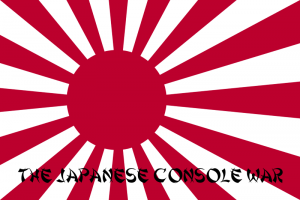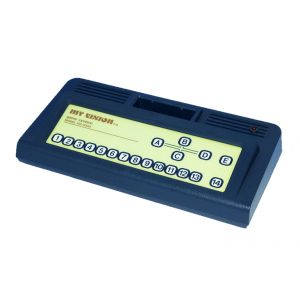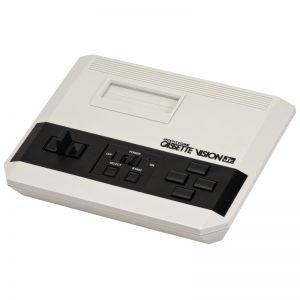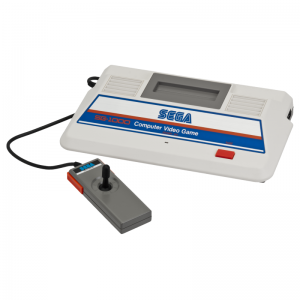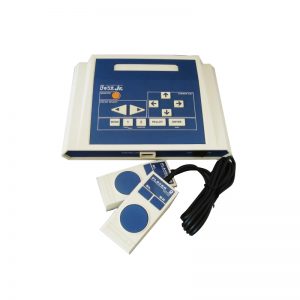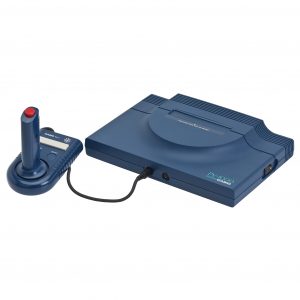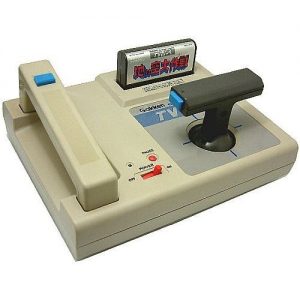While it is common knowledge that North America faced a Video Game crash in 1983, few knows about the Japanese Console War that happens around the same time. If we look back at the Japan video game landscape at the beginning of the eighties, you will see that very few Japanese console existed. Some company such as Bandai and Epoch imported North American console into Japan, but due to the high price tag, they never became popular. In 1983, the Japanese video game market was ready for home console, and while the market was crashing on the other side of the ocean, the Japanese one was blooming. From arcade to toy makers, everybody wanted to be the first to market to what would become a multi-billion-dollar industry.
Over a span of a few months, 7 home video game consoles were released in Japan. We all know how the story end. The Nintendo Famicom emerged as the victor of this war and reinvigorated the North American video game market. Also known as the Nintendo Family Computer , the console was released on July 15, 1983, for a price of ¥14,800. The console sold 60 million units worldwide and more than and more than a thousand games were released for it.
But what about the 6 other consoles? Let’s us dig up the graves of those who didn’t survive the Japanese Console War.
May 9, 1983 – The My Vision by Nichibutsu | |||
July 19, 1983 – The Cassette Vision Jr. by Epoch | |||
July 15, 1983 – The SG-1000 by SegaReleased the same day as the Nintendo Famicom, the SG-1000, was Sega’s answer to the Nintendo flagship console. In 1982, after pulling out of the arcade industry, Sega decided to move to the home computer market and started to work on the SC-3000, a computer with a built-in keyboard. When Sega learned of Nintendo’s plans to release a games-only console, they quickly decided to follow the same path and released the SG-1000. The SG-1000 was, by far, the most successful console behind the Nintendo Famicom, but even with more than 160,000 units sold, the console was no match for Nintendo’s flagship console. Sega slighted updated the deigns one year later with the release of the SG-1000 II, but with no hardware change, the console was still under-powered compared to the Famicom and also felt into the abyss. Sega would finally release the Sega Mark III (Sega Master System) in 1985 which would eventually become a more serious challenger to the Famicom domination. Price: ¥15,000 Discontinued: July 1984 Number of games : 75 | |||
July 1983 – The Pyuta Jr. by TomyThe Pyuta Jr. is the “consolize” of the Tomy Pyuta, a 16-bit computer released by Tomy a year earlier. Price at ¥59,800, the computer had a good start, selling more than 40,000 units in the first few months, but in July 1983, with the release of the Nintendo Family Computer (Famicom), the sale dropped drastically. To fight back, Tomy decided to drop the price of their computer and to release the Pyuta Jr. Priced at ¥19,800, the console was compatible with all the games of the Pyuta. Although the system uses a 16-bit CPU, the games were looking more like upgraded ColecoVision graphics, which made it hard to compete with the Famicom. As the Pyuta Jr. was basically a Pyuta computer in a console shell, the cost of keeping this console alive was not very high, especially since the games were being designed for the computer version anyway. But in the end, the console didn’t sell well at all and was discontinued alongside the Tomy Pyuta in 1985. Price: ¥19,800 Discontinued: 1985 Number of games : 26 | |||
October 1983 – The PV-1000 by Casio | |||
October 1983 – The Compact Vision TV Boy by GakkenGakken is a Japanese is publishing company founded in 1947. Although their main revenue stream is magazine, Gakken decided to dabble with educational toys in the ’70s. Between 1980 and 1983, Gakken released a ton of handhelds and tabletop game, the most notable being Super Puck Monster, a Pac-Man clone, that was later licensed by Coleco and released as the Coleco Pac-Man mini arcade. At the time, the Epoch Cassette Vision had 70% of the market share while the other more advance systems like the Arcadia 2001, the Intellivision, the Odyssey2 or the Epoch Cassette TV Game (Atari 2600) only capture a fraction of the market due to their high retail price. Gakken decided to use the same approach as the Epoch Cassette Vision by creating a low-cost video game system and a low-cost computer system. The Gakken Compact Vision TV Boy was finally released on October 1983. But by the time of its release, the video game landscape had changed completely. The Famicom was dominating the market and the price of the console had significantly dropped. Gakken’s console had little to no success and as quickly discontinued and the microcomputer project was ultimately cancelled.
Price: ¥8,800 Discontinued: 1983 Number of games : 6 | |||
Any comments? Join us on our Facebook Page or our Facebook Group.

